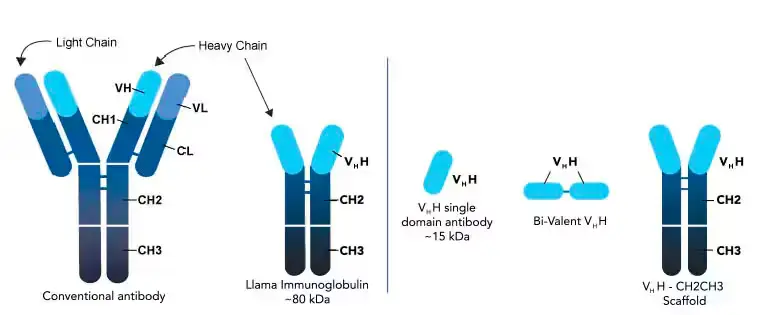The 2019 COVID-19 pandemic highlighted the unique properties of llama antibodies and the field of research they spawned more than 20 years ago. Llama antibodies have garnered attention for their unique properties and effectiveness against pathogens both viral and bacterial. Researchers are exploring the fascinating world of llama antibodies, their differences from human antibodies, and how they can play a crucial role in the development of new therapies and vaccines.
This is a link to a website for a company that focuses on providing products for treatment and control of disease based on products developed from the template of llama antibodies. Note the name “Llamabody”
https://www.rndsystems.com/products/llamabody-camelid-antibodies
Understanding Llama Antibodies

What Are Llama Antibodies?
Llamas, alongside their relatives in the Camelidae family such as camels and alpacas, produce two distinct types of antibodies in response to foreign invaders. These include conventional antibodies similar to those found in humans and smaller, single-domain antibodies known as nanobodies. Remarkably, nanobodies are about one-tenth the size of conventional antibodies, which enhances their ability to bind to target proteins effectively. This unique structural advantage allows for easier manipulation in laboratory settings, making llama antibodies particularly appealing for therapeutic applications against various pathogens, including viruses.
How Llama Antibodies Differ from Human Antibodies
The structural and functional differences between llama antibodies and human antibodies are significant. While human antibodies are composed of two heavy and two light chains, llama antibodies consist of a single polypeptide chain. This structural simplicity allows for the creation of nanobodies that are not only smaller but also more stable, enabling them to bind to multiple sites on a target protein. These unique properties empower llama antibodies to penetrate deeper into the pathogen’s surface, effectively neutralizing them. Additionally, the production of nanobodies can be achieved more rapidly and at a lower cost compared to traditional antibodies.
Mechanism of Action Against Viruses
Llama antibodies, particularly the extraordinary nanobodies, operate through a sophisticated mechanism that allows them to neutralize viruses effectively. By binding to specific viral proteins, such as the spike protein of SARS-CoV-2, these antibodies inhibit the virus’s ability to enter host cells. This binding plays a crucial role in preventing infections and highlights the potential of llama antibodies in therapeutic applications. Their small size enables access to densely packed regions on the virus, which larger human antibodies may struggle to reach, thereby enhancing neutralization efficacy.
This article: https://pubmed.ncbi.nlm.nih.gov/38841291/ provides an overview of the multiple research and development fronts in immunology and epidemiology that have been opened since the discovery and recognition of llama antibodies unique properties that overcome the limitations of vaccines and palliatives.
How Llama Antibodies May Provide Protection
The inherent properties of llama antibodies, such as their remarkable stability and reduced size, suggest they could significantly enhance protection against a variety of viral and bacterial infections. Research has shown that llama-derived nanobodies can be engineered to neutralize multiple strains of viruses, including various SARS-CoV-2 variants. Additionally, the ability to nebulize these antibodies allows for direct delivery to the respiratory tract, providing immediate protection for at-risk individuals. Their rapid production and adaptability make llama antibodies an appealing option for emergency responses in the face of pandemics.
Llama Antibodies in Vaccine Development
Llama antibodies are being explored for their potential in vaccine development due to their unique binding capabilities and stability. Researchers are investigating how these antibodies can be incorporated into vaccines to enhance immune responses against various pathogens. The ability of llama nanobodies to neutralize multiple strains of a virus could lead to the creation of broad-spectrum vaccines that provide long-lasting immunity. Furthermore, their small size allows for easier integration into vaccine formulations, potentially improving the delivery and efficacy of the vaccines.
This link is to an article that is a technical discussion of llama antibodies use in treating disease and potential to produce broad spectrum vaccines against various diseases and conditions.
https://pmc.ncbi.nlm.nih.gov/articles/PMC11108896/#Sec1
Future Prospects for Antibodies from Llamas
The future of llama antibodies in medicine looks promising, with ongoing research aimed at harnessing their unique properties for therapeutic applications. Scientists are exploring the development of inhalable treatments that could provide immediate protection against respiratory pathogens, as well as cancer treatments and pain management. As research progresses, llama-derived nanobodies will become integral components of antiviral therapies and vaccines, offering a rapid response to emerging infectious diseases. The adaptability and effectiveness of these antibodies could lead to innovative solutions in public health, particularly in resource-limited settings. related to immunology and antibody research.

